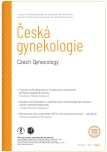Comparison of dinoprostone, misoprostol and amniotomy in labor induction
Authors:
E. Hostinská
; Šinská A.; Ľubušký M.; Pilka R.
Authors‘ workplace:
Porodnicko-gynekologická klinika LF UP a FN Olomouc
Published in:
Ceska Gynekol 2021; 86(6): 368-373
Category:
Original Article
doi:
https://doi.org/10.48095/cccg2021368
Overview
Objective: Comparison of dinoprostone, misoprostol and amniotomy in labor induction. Methods: The study group included a total of 437 women who underwent consecutive induction of labor after evaluation of the indication and Bishop’s score. The most common indications were: postmaturity, hypertensive disease, diabetes mellitus and fetal growth restriction. In 327 cases we chose to induce labor using vaginal tablets of dinoprostone at a dose of 0.75 mg, in 36 cases dinoprostone at a dose of 3 mg, in 16 cases we used a vaginal insert of misoprostol (200 µg), and in 58 cases amniotomy was performed. Results: In the subgroup of dinoprostone (0.75 mg) the rate of vaginal delivery (including extraction delivery) was 90.2%, in the subgroup of dinoprostone (3 mg) it was 91.6%, in the subgroup of misoprostol it was 100% and in the subgroup of amniotomy it was 93.1%. The time period between onset of labor induction and delivery was an average of 15.75 hours in the dinoprostone (0.75 mg) subgroup, 21.41 hours in the dinoprostone (3 mg) subgroup, 17.41 hours in the misoprostol subgroup and 7.49 hours in the amniotomy subgroup. Conclusion: Subgroup of patients with misoprostol showed the highest rate of vaginal delivery after labor induction. In the subgroup with amniotomy, the shortest time period between onset of induction and delivery was reached.
Keywords:
predictive factors – Bishop score – induction of labor – nulliparity
Sources
1. Chen W, Xue J, Peprah MK et al. A systematic review and network meta-analysis comparing the use of Foley catheters, misoprostol, and dinoprostone for cervical ripening in the induction of labour. BJOG 2016; 123 (3): 346–354. doi: 10.1111/1471-0528.13456.
2. Tsakiridis I, Mamopoulos A, Athanasiadis A et al. Induction of labor: an overview of guidelines. Obstet Gynecol Surv 2020; 75 (1): 61–72. doi: 10.1097/OGX.0000000000000752.
3. Bacak SJ, Olson-Chen C, Pressman E. Timing of induction of labor. Semin Perinatol 2015; 39 (6): 450–458. doi: 10.1053/j.semperi.2015.07.007.
4. Navve D, Orenstein N, Ribak R et al. Is the Bishop-score significant in predicting the success of labor induction in multiparous women? J Perinatol 2017; 37 (5): 480–483. doi: 10.1038/jp.2016.260.
5. Alfirevic Z, Keeney E, Dowswell T et al. Which method is best for the induction of labour? A systematic review, network meta-analysis and cost-effectiveness analysis. Health Technol Assess 2016; 20 (65): 1–584. doi: 10.3310/hta20 650.
6. Swamy GK. Current methods of labor induction. Semin Perinatol 2012; 36 (5): 348–352. doi: 10.1053/j.semperi.2012.04.018.
7. Villalain C, Quezada MS, Gómez-Arriaga P et al. Prognostic factors of succesful cervical ripening and labor induction in late-onset fetal growth restriction. Fetal Diagn Ther 2020; 47 (7): 536–544. doi: 10.1159/000503390.
8. Little SE. Elective induction of labor: What is the impact? Obstet Gynecol 2017; 44 (4): 601–614. doi: 10.1016/j.ogc.2017.08.005.
9. Hawkins JS, Wing DA. Current pharmacotherapy options for labor induction. Expert Optin Pharmacother 2012; 13 (14): 2005–2014. doi: 10.1517/14656566.2012.722622.
10. Dey I, Lejeune M, Chadee K. Prostaglandin E2 receptor distribution and function in the gastrointestinal tract. Br J Pharmacol 2006; 149 (6): 611–623. doi: 10.1038/sj.bjp.0706923.
11. Redling K, Schaedelin S, Huhn EA et al. Efficacy and safety of misoprostol vaginal insert insert vs. oral misoprostol for induction of labor. J Perinat Med 2019; 47 (2): 176–182. doi: 10.1515/jpm-2018-0128.
12. Cooley SM, Geary MP, O’Connell MP et al. How effective is amniotomy as a means of induction of labour? Ir J Med Sci 2010; 179 (3): 381–383. doi: 10.1007/s11845-010-0502-6.
13. Gabbay-Benziv R, Hadar E, Ashwal E et al. Induction of labor: does indication matter? Arch Gynecol Obstet 2016; 294 (6): 1195–1201. doi: 10.1007/s00404-016-4171-1.
14. Battarbee AN, Glover AV, Stamilio DM. Association between early amniotomy in labour induction and severe maternal and neonatal morbidity. Aust N Z J Obstet Gynaecol 2020; 60 (1): 108–114. doi: 10.1111/ajo.13031.
15. Dunn L, Kumar S, Beckmann M. Maternal age is a risk factor for caesarean section following induction of labour. Aust N Z J Obstet Gynaecol 2017; 57 (4): 426–431. doi: 10.1111/ajo. 12611.
16. Dhanjal MK, Kenyon A. Induction of labour at term in older mothers. Scientific Impact Paper No. 34. UK, London: Royal College of Obstetricians and Gynaecologists 2013.
17. Carpenter J. Intrapartum management of the obese gravida. Clin Obstet Gynecol 2016; 59 (1): 172–179. doi: 10.1097/GRF.0000000000000174.
Labels
Paediatric gynaecology Gynaecology and obstetrics Reproduction medicineArticle was published in
Czech Gynaecology

2021 Issue 6
Most read in this issue
- The role of the microbiome in pregnancy
- Comparison of dinoprostone, misoprostol and amniotomy in labor induction
- Breast reconstruction in patients with BRCA mutation and breast cancer – our approach
- Covid-19 as a possible risk factor of intrauterine fetal death
